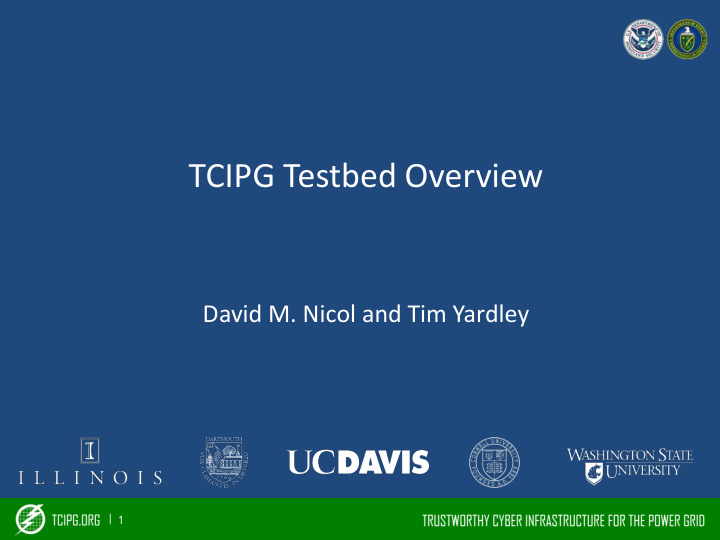



TCIPG Testbed Overview David M. Nicol and Tim Yardley | 1
Testbed Overview • Testbed equipment and simulators span the grid system – Generation • Power system modeling, RTDS – Transmission & Distribution • Relays, Substation computers, PMUs, PDCs • EMS, Planning, Protocol test-harnesses Advanced metering – Meter platforms, emulation testbed • Consumers – Energy monitoring, Home automation • | 2
Testbed Tour | 3
Testbed Tour | 4
Testbed Tour | 5
Testbed Problem Statement Testbed aims to support academic and industrial evaluation of TCIPG and other Smart Grid technologies Experimental evaluation is critical for emerging technologies – Challenge is to create virtual environment faithful to reality … – That is measurable, repeatable, flexible, and adaptable to emerging technology while maintaining integration with legacy gear Leverages multiple funding sources to provide efficiency | 6
Testbed Objectives • Diverse inventory of domain-specific hardware, software and simulators • Integration of live hardware/software, hardware and software simulators/emulators into a unified virtual environment • Intuitive description of experiment followed by automated configuration and data harvesting • Repeatability • Federation | 7
Testbed Impact • The testbed has – Enabled researchers to test out algorithms using real data and real hardware – Spurred new activities and research revelations through use of the facilities – Generated project specific tools that are being evaluated for generic inclusion | 8
Testbed Key Accomplishments • Horizontally and vertically scalable virtualization platforms in use and to be expanded with use of DETER • Creation and polishing of research tools for integration into the testbed • Leveraging industry provided data (e.g., PMUs) and provide a repository for secure data redistribution amongst approved researchers | 9
Testbed Tasks Completed • Integration of new hardware and software to augment research capabilities (RTDS, power modeling, protocol harnesses, data concentration, security monitoring and assessment) • Integration of DETER experimentation framework to provide dynamic computer resource allocation and hierarchical topologies • Domain-specific traffic generation, interception, and coupling with simulation systems • Evaluation of emerging technologies for their use in the testbed and pursuit of applicable technology through both donation and purchasing | 10
Example use of Testbed by TCIPG Activities • Topology Perturbation for Bad Data Detection – Leverages RTDS, DETER, and other testbed resources extensively to provide modeling and validation of research ideas • Specification-based IDS for AMI – Leverages smart-meter testbed emulation to prototype and refine research • S3F Network Simulation Engine – Leverages testbed hardware and domain-specific software to advance scaled cyber-physical simulation | 11
Testbed Directions for Coming Year • Ongoing expansion of DETER to support vertically scaled resources and customized integration of domain-specific hardware • Expansion of automated reconfiguration of domain-specific hardware and software • Increased interaction with industry and other testbeds to evaluate technology use, match direction, provide insight, and increase engagement | 12
Questions and Discussion | 13
Recommend
More recommend